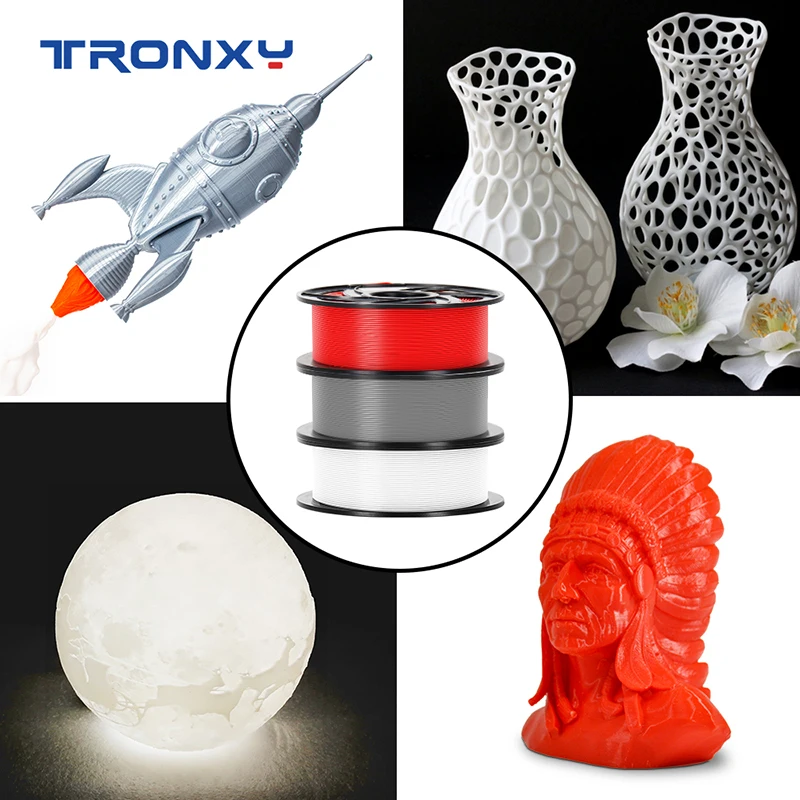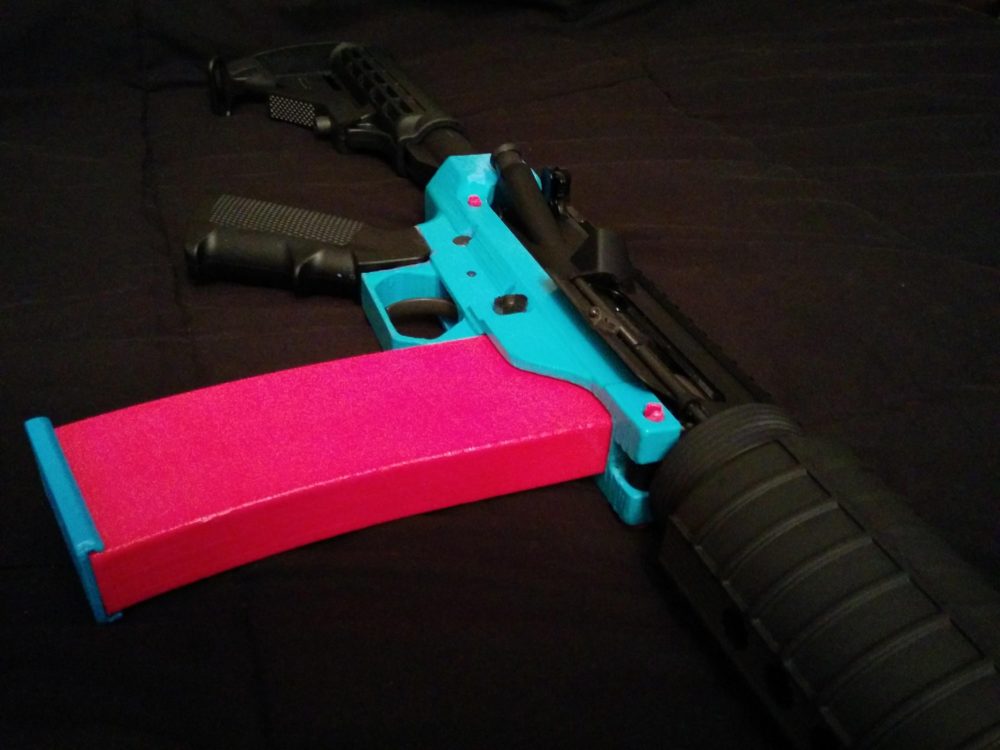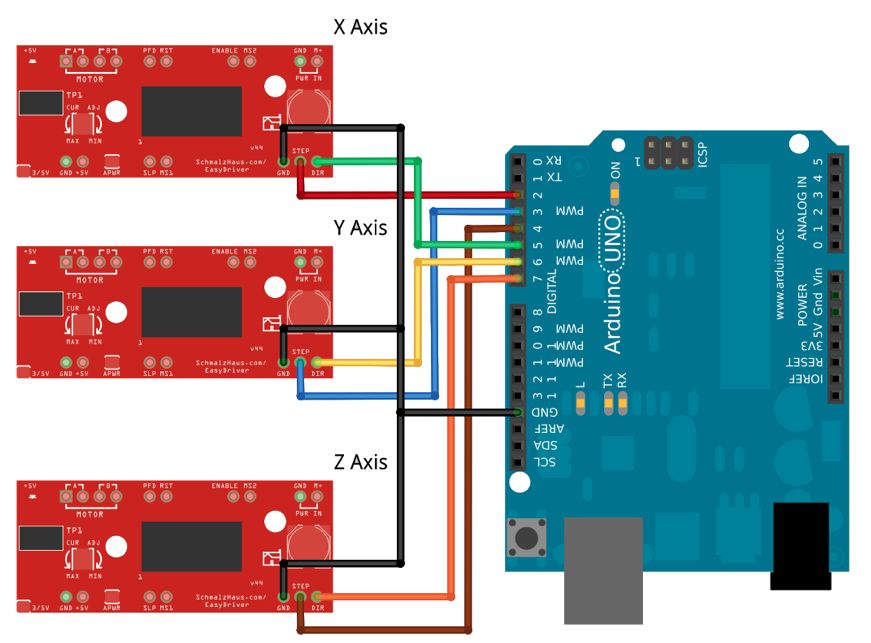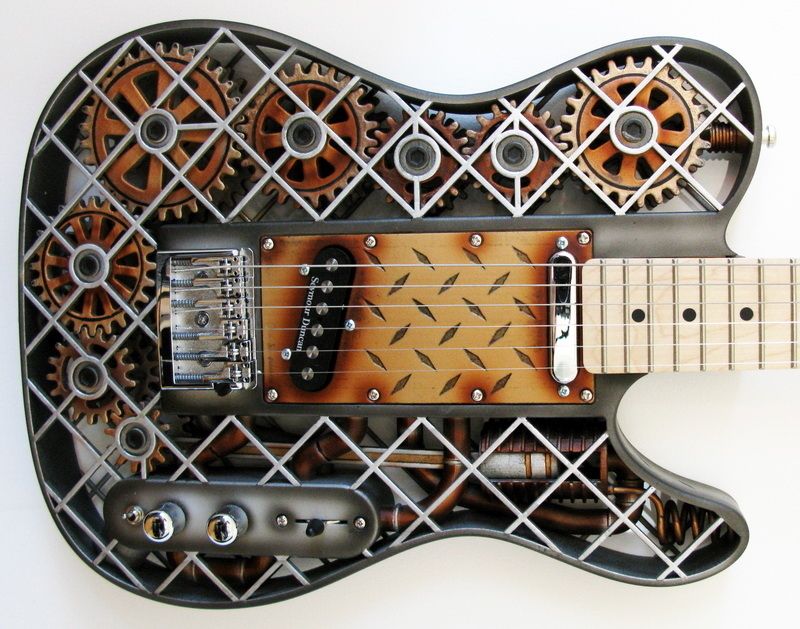Best clear 3d printer filament
Which is the Best Clear 3d Filament - Ultimate Guide
Everyone goes through various struggles when choosing the clear filament for the first time. There are several types of clear filament on the list.
So if you have trouble making your decision, you are just getting the start, or you need to test all the material – don’t worry.
You are in the right place. Here are so many plastic materials could be used in 3d printer. The most commonly used clear or transparent 3D printer filaments are PLA, PMMA, PETG, PET, Clear ABS, Polycarbonate, and TPU. Let’sLet’s talk about the positives, negatives, and best printing tips one by one.
The natural PLA resin is not clear. It has a very faint yellow tinge. If you compared with clear PLA filament from different manufacturers, there will be a slight difference. The tip is the process temperature. If the temp setting is higher, PLA resin could be perfect recrystallization. Then the filament will be more transparent.
The transparency is different from the resin manufacturer. There are two manufacturers for PLA raw resin. One is NatureWorks, the other is Hisun, We have made opacity tests with 4032D, 4043D(from Naturelwork), and 190(from Hisun), The opacity of 190 is much better than 4032D and 4043D.
Liking ABS, PLA is a commonly used filament in 3d printing. It is biodegradable and has excellent properties. Translucent PLA filament is one of the easiest to print clearly and get good results. To get the smooth finish of the surface, sanded is needed after printed. The part is close to the clear after filed.
Choose the right sandpaper is essential. This depends on the layer height in the setting. Thicker layers need courser sandpaper. Then use more delicate and finer grits, sanding in a circular motion each time (this bit is crucial because you’re trying to remove all surface imperfections). Start at the start, maybe 800 grit, and upwards in 200 increments from there. Finish with 3000 or higher grit to get a smooth finish.
The nature of abs is not transparent.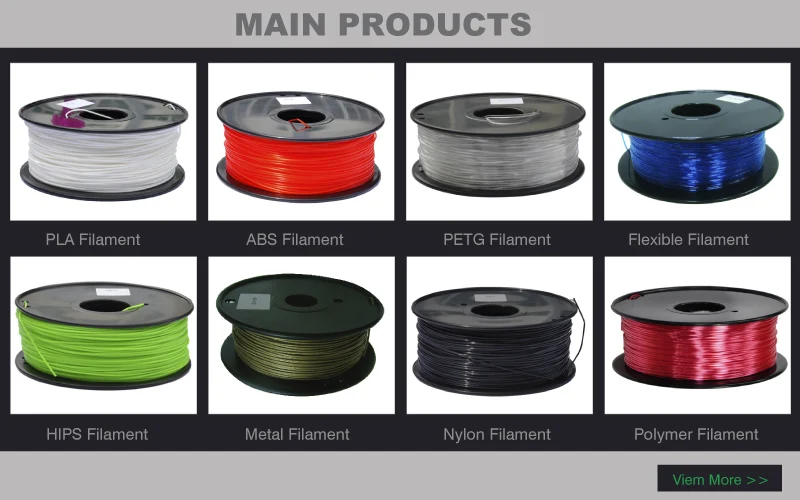 Clear abs are the particular type of abs material. The short name is MBS. Other additives will add to make it clear.
Clear abs are the particular type of abs material. The short name is MBS. Other additives will add to make it clear.
Clear abs filament cannot print as clear as the material. It needs to be post-print finished with Acetone vapor smoothing.
PETG is a durable clear 3D filament with excellent layer adhesion (almost unbreakable) and less shrinkage than other filaments; it’s great for 3D printing clear, big stuff that won’t break under pressure. It is odorless when printing and often produces clear, smooth finishes. Meanwhile, PETG has abs material’s flexibility and PLA’s strength.
PETG can’t smooth with acetone pour, but it can sand. Compared with PLA sanding, PETG printed object is smoother, which means that you need to use higher grit.
PMMA is the most transparent material so far. It has high strength and impact resistance.
PMMA is commonly used to replace glass in a particular application, such as cellphone screen and sunshine glass. The opacity of pmma is about 92%, much more than other clear plastic.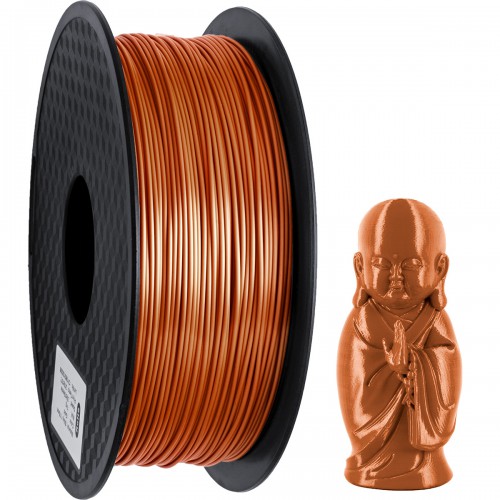
Polycarbonate
Polycarbonate is an extremely durable and optically transparent 3D printing filament that should print in a warm environment. Its durability can be bent repeatedly without cracking, making it great for creating all sorts of hipster jewelry.
But seriously, Polycarbonate (PC) is an immensely underrated material to print. It finishes with a nice glossy sheen to it. It needs a very hot extruder to print it usually, and if you’re looking for translucent results, we’d recommend going even hotter still (300 C+).
A great advantage with PC is that it can smooth with acetone like ABS to bring out more apparent results.
TPU is the only flexible material used for clear parts. It has good elongation and flexibility. Due to this property, Tpu is commonly used in bracelets and use wine and charge wine.
About the Tpu filament, printer settings are different from other materials. The extruder structures are different, and the printing speed is slower. For the details, we will write on the next page.
For the details, we will write on the next page.
Summary
PETG is your first choice for clear filament. It has suitable property and is nicely finished. Meanwhile, if you need flexible material, TPU has the advantage.
Need Any Services? Contact Us Now!
Top 5 Best Clear 3D Printing Filaments
3D Insider is ad supported and earns money from clicks, commissions from sales, and other ways.
Making clear or transparent projects is one of the most interesting things you can do with 3D printing. If you know what you’re doing, you can make custom frames for photos or a glass-like vase for flowers. Just a disclaimer here – 3D-printed plastics are closer to being translucent than truly transparent. It is simply a limitation of the technology.
There are several different filaments that can be used to make clear builds. They are not all equally made. One filament may have better optical properties, but the others may be more durable or easier to work with. Let’s look at our top five options for clear filaments.
Let’s look at our top five options for clear filaments.
1. PETG
PETG has a couple of advantages that make it our top choice for clear filaments. The first is that it’s one of the few 3D printing plastics that is naturally clear. This helps in achieving the best optical properties, despite the limitations of 3D printing.
It also helps that PETG is considered the filament that combines many of the best things about other popular 3D printing filaments. It has good thermal resistance, mechanical strength, chemical stability, and is not prone to warping during printing. PETG is considered by many to be one of the easiest filaments to work with and is quickly becoming very popular in 3D printing communities.
Of the available options out there for clear PETG filament, the OVERTURE Transparent PETG filament is one of the most popular. The clarity of prints from this filament are impressive, even before post-processing. It’s also not very expensive at only a little above $20 for a 1-kilogram spool.
2. PMMA
Polymethylmethacrylate (PMMA) is not a very common material used in 3D printing. There are good reasons for this, but it’s also one of the best candidates for making clear or translucent projects. After all, PMMA is the same material used in acrylic sheets.
Aside from its good optical properties, PMMA is UV-resistant and is very strong and long-lasting. Like ABS, PMMA can be dissolved by acetone. This means that PMMA prints can be smoothed by acetone vapor, one of the easiest and most reliable post-processing methods. This is a huge advantage as smoothing can massively improve the optical properties of a finished print.
The downsides of PMMA are quite notable, contributing to why it’s not very popular for 3D printing. Like many other high-temperature filaments, PMMA is prone to warping. It is also a toxic material. If you want to create something meant for food contact, using PMMA should be out of the question.
Since it’s not very popular, there are not many options when it comes to clear PMMA filament. The only brands available on Amazon are MSNJ and QDTD. These aren’t exactly household names in 3D printing, so you’ll have to take a bit of a gamble.
The only brands available on Amazon are MSNJ and QDTD. These aren’t exactly household names in 3D printing, so you’ll have to take a bit of a gamble.
3. PLA
PLA is not a naturally clear material, but some chemical treatment has yielded a host of clear PLA filaments. This material needs no introduction. It is one of the most popular 3D printing filaments because of how easy it is to use. PLA does not warp, does not emit an unpleasant smell during printing, and is sourced from sustainable plant material.
Since PLA is not naturally clear, it is not the best option in terms of optical properties. Clear PLA prints often come out with a faint yellow or white tinge. Quality can vary from one filament brand to another.
If you’re buying clear PLA filament, we suggest sticking with the tried-and-true brands. The best option is either SUNLU or Gizmo Dorks. Both filaments are inexpensive, although the filaments from these brands have been known to be hit-or-miss in terms of printing performance.
4. Nylon
Nylon is another thermoplastic that benefits from being naturally clear. You have probably already seen how close to being transparent Nylon plastic bags or films are. 3D printing with Nylon comes close to this optical quality.
Nylon is known as a particularly durable but lightweight material. It is exceptionally strong and is resistant to chemical degradation and physical abrasion. If you’re worried about your product getting scratched easily, then Nylon may be your best option for filament.
The biggest downside of Nylon is that it’s highly prone to warping. Getting good prints with Nylon means using every trick in the bag to improve bed adhesion – a heated bed, adhesives, a cooling fan, perhaps even printing with a raft or brim. Nylon is also exceptionally hygroscopic, so you will have to figure out how to keep it dry while printing.
There are several good Nylon filaments available. We recommend the Natural Clear Nylon Filament from Gizmo Dorks.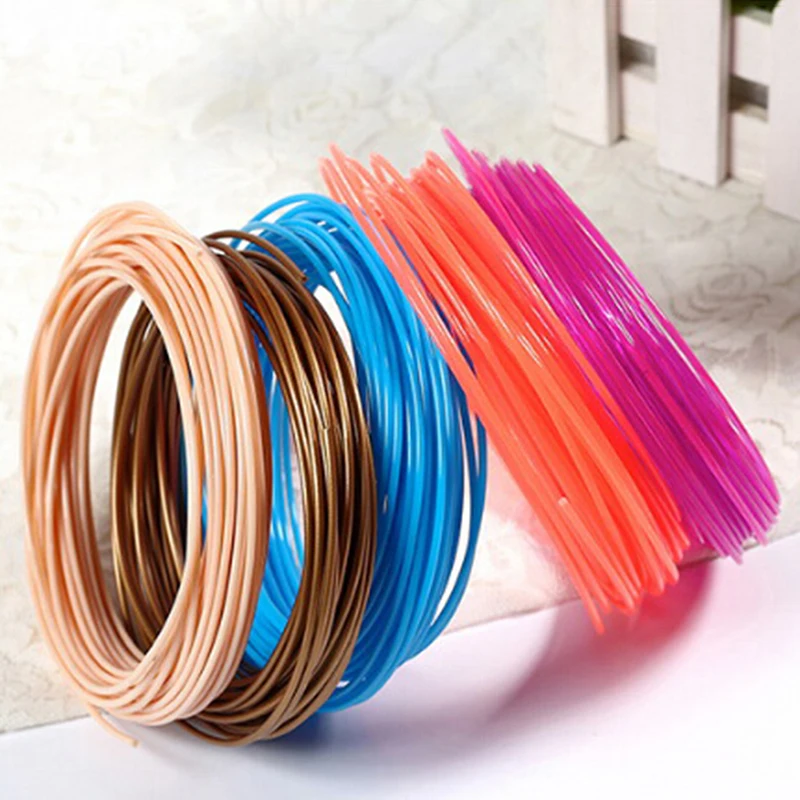
5. TPU
The operative word when describing TPU is ‘flexible.’ TPU is the go-to filament if you want to 3D print products that are rubber-like and have very high impact resistance. It is usually used in making protective sleeves or cases for sensitive electronics. TPU can be prepared to be naturally clear upon manufacturing.
TPU can be uniquely challenging if you have never worked with it before. The most common issue encountered with TPU is stringing, owing to its very low viscosity. It is often advised to print slowly, at low temperatures, and with retraction enabled. It might take a bit of trial and error, but it’s certainly doable.
There is a wide selection of clear TPU filaments available. Among the most trusted are the NinjaTek Cheetah TPU Filament, TRONYX Clear Flexible TPU, and PolyMaker High Flow TPU Filament.
Tips on making clear 3D prints
Even when printing with clear filament, the optical quality of the finished product is not guaranteed.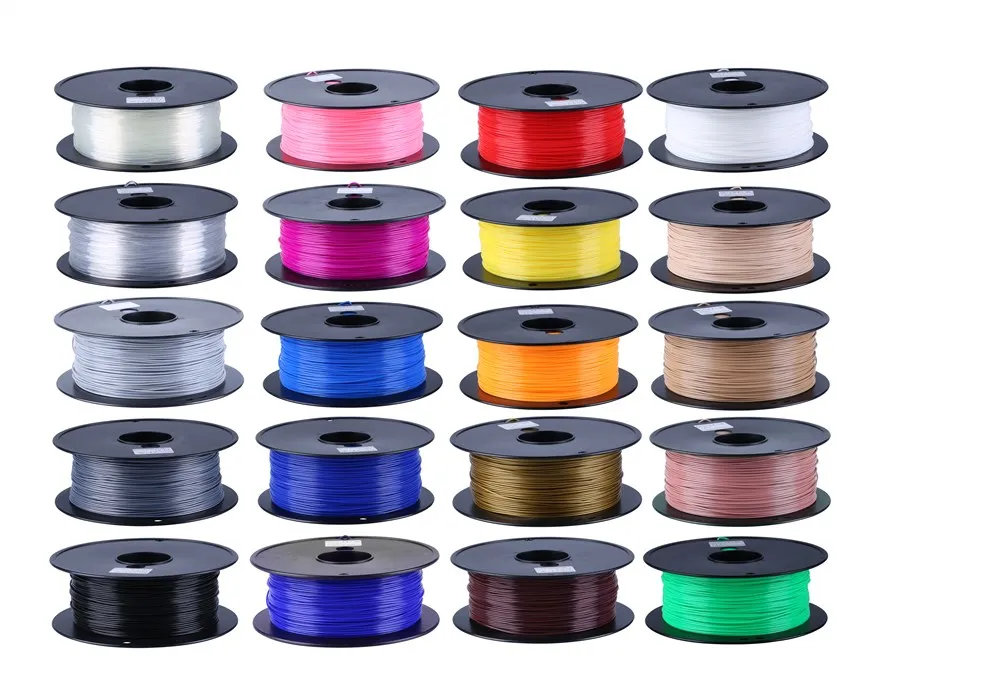 If you want to make your prints as close to transparent as possible, you will have to tweak your printer settings based on some basic optics concepts.
If you want to make your prints as close to transparent as possible, you will have to tweak your printer settings based on some basic optics concepts.
Print with thick layers
To make an object transparent, we will have to reduce any internal diffraction or reflection. This can be hard to do in 3D printing, as the boundaries between layers will almost certainly disrupt the path of light rays, especially if the layers are not completely fused.
To avoid this problem, it is advised to print with as high a layer thickness as possible. This reduces the number of layer boundaries and makes the layers more spherical. With this setup, internal reflections are minimized. You can even consider using a nozzle with a wider diameter just to take advantage of this phenomenon.
Print at high temperatures
Another goal you should aspire for when 3D printing clear objects is to make the layers fuse with each other as well as possible. This minimizes internal reflection and light diffractions through the layer boundaries.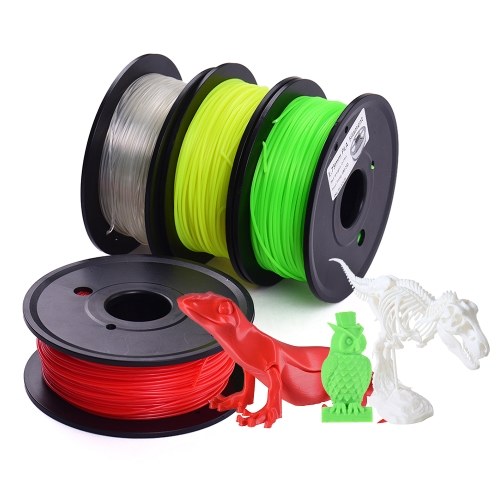
The conventional wisdom would be to print at the highest allowed temperature for the filament that you are using. You can experiment a bit and go beyond the recommended temperature by a few degrees in the hopes of improving the optical properties of the finished product. Just keep an eye out for stringing or over-extrusion problems. This is not a strategy that we would recommend for printing with TPU.
Print at 100% infill
If you’re making solid pieces, then the only way to really achieve good transparency is to print at 100% infill. Light reflects and refracts when it passes through different materials. If the infill of your product is only partially filled, it would be almost impossible for light to pass through at all. You will just end up with something that seems clear on the outside but has a solid white core.
Smooth and polish
Taking the time to smooth and polish your finished print goes a long way towards achieving a close-to-transparent look. This gets rid of any surface imperfections and may even dull away the layer boundaries.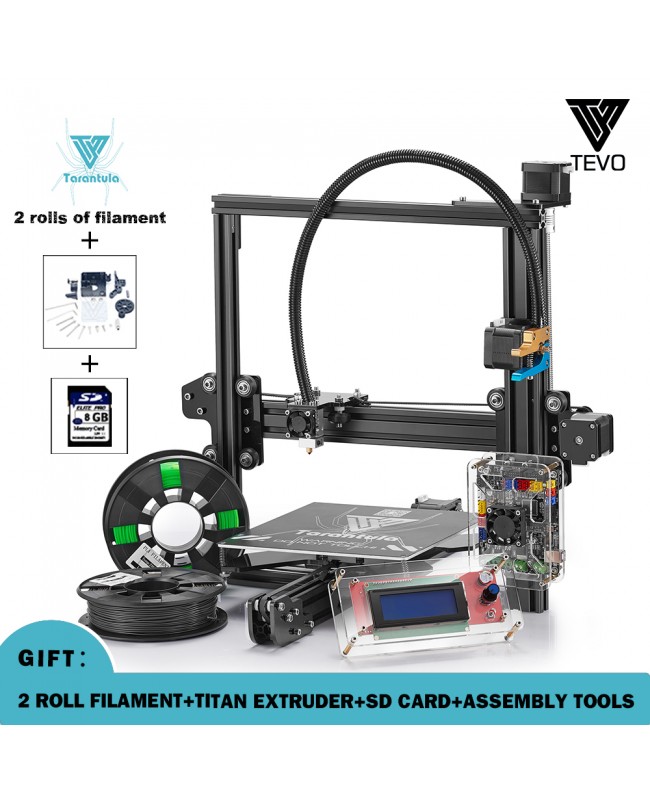 Again, this reduces any untoward reflection or refraction and makes it easier for light to pass through.
Again, this reduces any untoward reflection or refraction and makes it easier for light to pass through.
The usual way to finish a 3D print is by sanding. Although old-fashioned, this is still the best and most precise way of post-processing. You will want to do this using sandpaper with different grit grades, finishing off with one that is incredibly fine. A 4000-grit sandpaper should do very nicely
Sanding is the recommended way of post-processing if you’re printing with PLA, PETG, Nylon, or TPU. If you’re using PMMA, then you have the luxury of exploring vapor smoothing with acetone. This method is a lot faster and gives fairly consistent results at a fraction of the effort involved.
Making transparent 3D prints can seem frustrating at first. There is basically no room for error, as a small misprint can quickly ruin the aesthetics of a project that is meant to be clear. A bit of understanding of how light behaves can go a long way towards helping you refine your technique.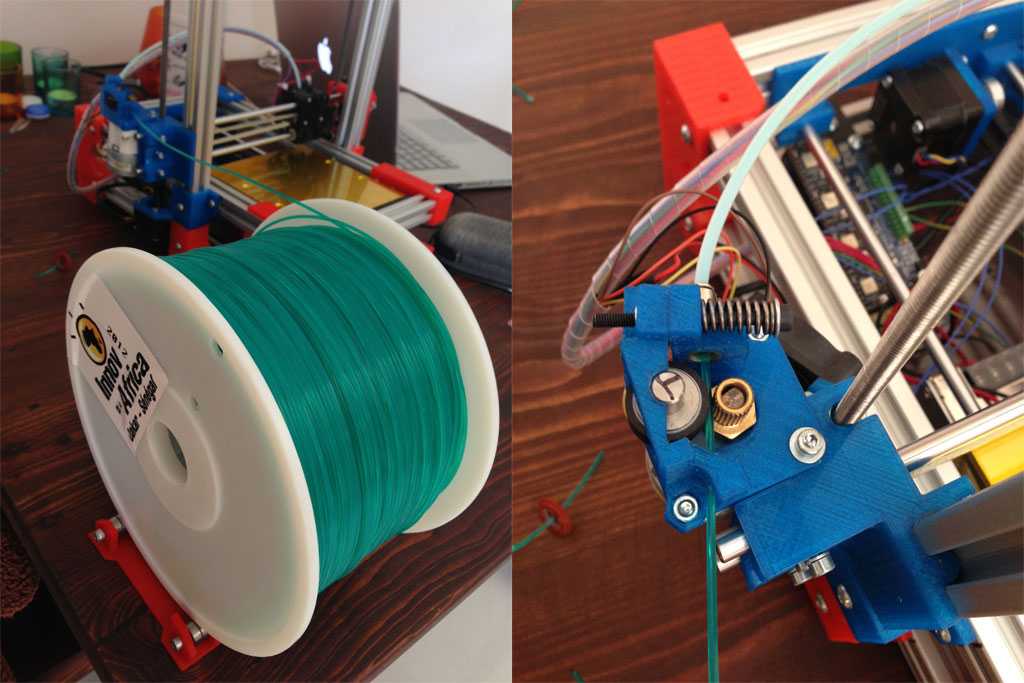
Final thoughts
There are lots of guides out there that repeat many of the same recommendations for 3D printing clear objects or surfaces. We have mentioned those as well – print with thick layers, high temperatures, and take it slow. Post-processing also plays a huge role.
Perhaps even more important is making sure that you’re printing with a high-quality clear filament. As we mentioned, not all clear filaments are made equal. You will probably get better results with PETG or Nylon compared to PLA.
Warning; 3D printers should never be left unattended. They can pose a firesafety hazard.
90,000 types of plastic for 3D printerContent
-
- Pla
- ABS
- HIPS
- PVA
- Petg
- SBS 9000
Every year 3D printing becomes more popular and accessible. Previously, a 3D printer was more like a complex CNC machine, but now manufacturers are meeting users. Simplified and automated settings that many beginners drove into a stupor.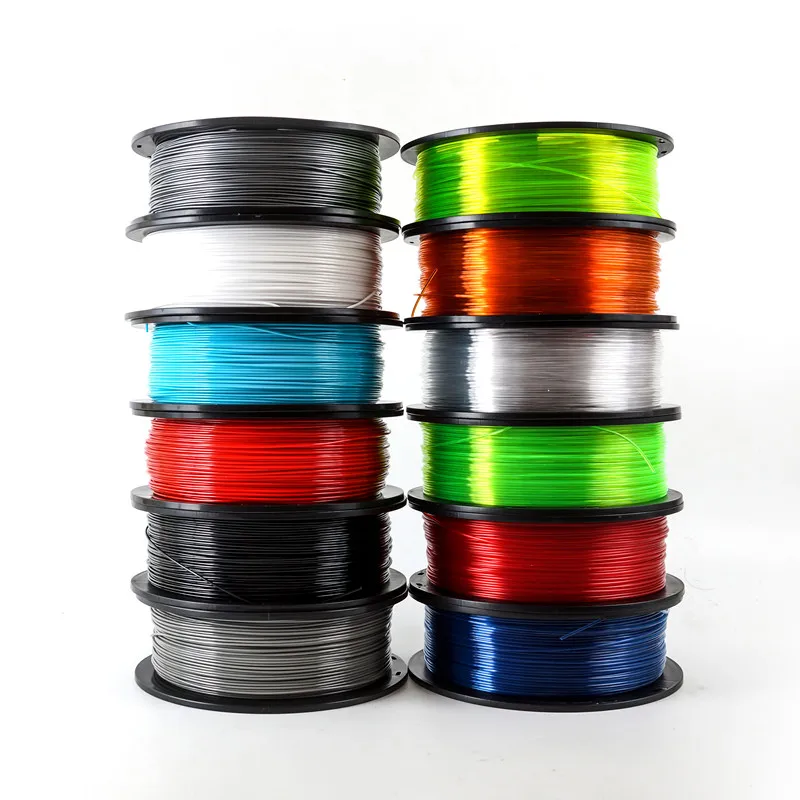 Despite this, it can be difficult for a novice user to understand the variety of constantly appearing plastics for a 3D printer.
Despite this, it can be difficult for a novice user to understand the variety of constantly appearing plastics for a 3D printer.
The choice of plastic for a 3D printer is very important, especially when the goal is to print a functional model with certain properties. It will be a shame if the printed gear breaks almost immediately, or the decorative model quickly loses its beauty.
It is important to understand whether the printer will be able to work with the selected plastic. Some materials (most often engineering) require certain conditions for successful printing.
First, decide which model you want to print. What properties should it have? Does the model need to be durable? Or is it a master model for further replication, in which the quality of the surface is important?
90% of 3D printers use 1.75 diameter filament. 3mm diameter is rare, but it is better to check in advance which size is used in your printer.
PLA
PLA (Polylactide) is the most popular and affordable 3D printer plastic. PLA is made from sugar cane, corn, or other natural raw materials. Therefore, it is considered a non-toxic, biodegradable material.
PLA is made from sugar cane, corn, or other natural raw materials. Therefore, it is considered a non-toxic, biodegradable material.
Extruder temperature - 190-220 degrees. Table heating is not needed, but if the printer's table has a "heater" for better adhesion, you can heat it up to 50-60 degrees. PLA is very easy to work with. The only requirement is to blow the model. There is practically no shrinkage in this material. When printed, it is practically odorless, and if it smells, it smells like burnt caramel.
Pros:
-
Does not shrink. This makes it easy to build prefabricated or huge models without changing dimensions.
-
There are no specific requirements for a 3D printer. Any working 3D printer will do. PLA doesn't need a heated table or a closed case.
-
Non-toxic. Due to this, during printing it does not smell or has a barely perceptible aroma of burnt caramel.
-
Diverse color palette.
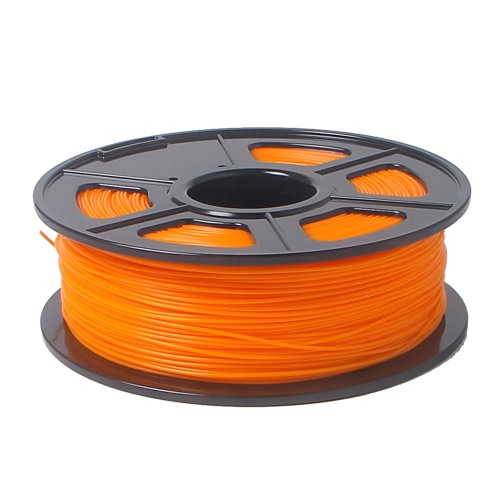
Cons:
-
PLA is poorly sanded and machined.
-
It begins to deform already with a slight heating (about 50 degrees).
-
Fragility. Compared to other materials, PLA is very brittle and breaks easily.
-
Decomposes under the influence of ultraviolet radiation. Of course, it will not fall apart into dust, but it can become more brittle and fade.
PLA is perfect for making dimensional or composite models. For example, decorative interior items, prototyping, electronics cases, etc.
Recently, PLA+ has appeared on the market. It may differ from conventional PLA in improved performance. For example, more durable, with improved layer adhesion.
Dummy turbine
Decorative coasters
ABS
ABS (acrylonitrile butadiene styrene) is the second most popular plastic for 3D printing due to its properties, availability and low price.
Extruder temperature - 220-240 degrees. The temperature of the table is 80-100 degrees. For printing, a heated table is required at the printer. It is desirable to have a closed chamber, because ABS "does not like" drafts. Due to a sharp temperature drop, it can “unstick” from the table or crack in layers. ABS can smell bad when printing, so it is recommended to use the printer with a closed chamber and filters, or print in a well-ventilated area.
Pros:
-
Good strength characteristics allow the production of functional prototypes from ABS.
-
Simple mechanical and chemical processing. ABS is easy to sand and drill, and with an acetone bath you can achieve a perfectly smooth surface.
-
It is currently the most inexpensive type of plastic for 3D printing.
-
Large selection of colors and shades.
Cons:
-
High shrinkage.
 Because of this, it can be problematic to manufacture overall products.
Because of this, it can be problematic to manufacture overall products. -
Printing requires a heated bed and a closed chamber. Without this, the ABS may peel off the table or crack in layers.
-
During the printing process, ABS can smell bad. Therefore, it is recommended that you print in a ventilated area or use the printer with a sealed chamber and filter.
ABS is an engineering plastic. It is suitable for the manufacture of simple functional products.
ABS after chemical treatment in an acetone bath
RU model made of ABS
ABS+ differs from conventional ABS in improved strength characteristics (elasticity, rigidity, hardness), less shrinkage and sometimes resistance to certain oils and solvents (eg gasoline).
HIPS
HIPS (high impact polystyrene) - originally conceived as a soluble support plastic for materials with high printing temperatures. For example for ABS or Nylon.
For example for ABS or Nylon.
The extruder temperature is 230-260 degrees. The temperature of the table is 80-100 degrees. It is desirable to have a closed camera for a 3D printer.
Pros:
-
Less shrinkage than ABS.
-
Ease of machining.
-
The matte surface looks very advantageous on decorative products.
-
Food contact allowed (but be sure to check with a specific manufacturer for certificates)
Cons:
-
For printing, you need a printer with a heated table and a closed chamber.
-
More flexible and less durable than ABS. Because of this, it will not be possible to produce functional products.
-
Small palette of colors.
Most often, HIPS is used for its intended purpose for printing on 2x extruder printers as a support for ABS. It dissolves perfectly (though not very quickly) in limonel.
Sometimes HIPS is used as an independent material. Products from it are not very durable, but this plastic is loved for easy post-processing. HIPS can be used for models that will subsequently come into contact with food (not hot).
Using HIPS as a Soluble Support
Decorative vase made of HIPS
PVA
PVA (polyvinyl alcohol) is a material that was developed as a water-soluble support for PLA.
Extruder temperature - 190-210. Table heating is not required. PVA is a slightly "capricious" material, it is not recommended to overheat it and print at high speeds.
PVA is very hygroscopic and dissolves in plain water. Therefore, it is only used as a support for PLA or other plastics with print temperatures close to PVA.
Soluble PVA Support
Add to compare
Item added to compare Go
| Manufacturer | Tiger3D |
Add to compare
Product added to compare Go
| Manufacturer | Tiger3D |
Add to compare
Product added to compare Go
| Manufacturer | Esun |
Add to compare
Product added to compare Go
| Manufacturer | Esun |
PETG
PETG (polyethylene terephthalate) combines the best properties of PLA and ABS.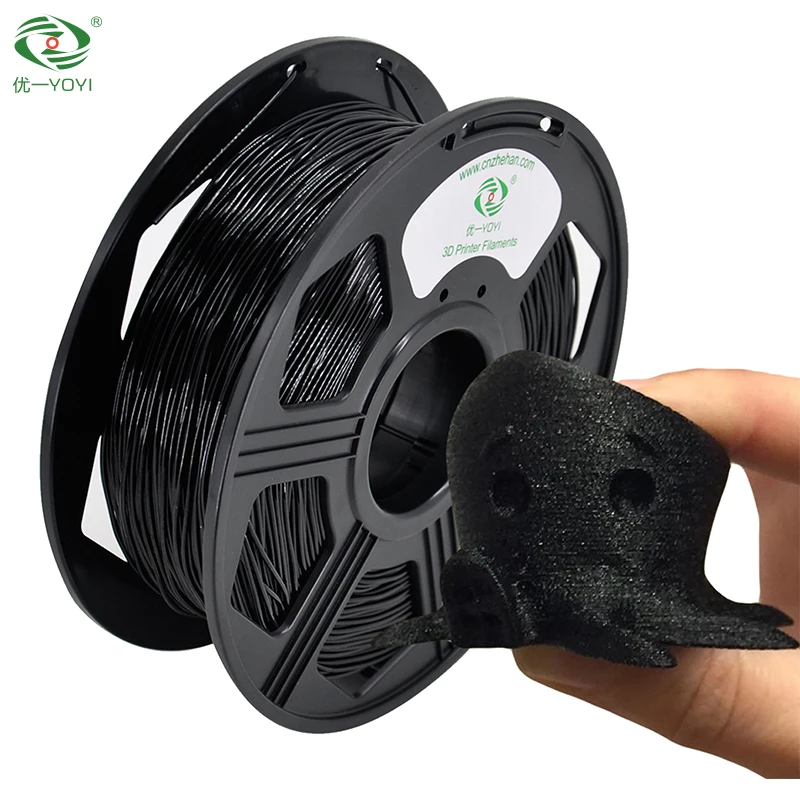 It is easy to work with, it has a low percentage of shrinkage and excellent sintering of the layers.
It is easy to work with, it has a low percentage of shrinkage and excellent sintering of the layers.
Extruder temperature - 220-240 degrees. Table temperature - 80-100 degrees. During the printing process, the model must be well blown.
Pros:
-
Excellent sinterability of layers.
-
PETG is very strong and wear resistant. Good impact resistance.
-
Virtually no smell when printing.
-
Non-toxic.
-
Little shrinkage.
Cons:
PETG is perfect for printing functional models. Due to its low shrinkage, it is often used to make large or composite models. Due to its low toxicity, PETG is often used for products that will come into contact with food.
Cookie cutters and patterned rolling pin
SBS
It is a highly transparent material. At the same time, it is durable and resilient. SBS is a low toxicity plastic. It can be used to print food contact models.
SBS is a low toxicity plastic. It can be used to print food contact models.
Extruder temperature - 230 -260 degrees. Table temperature - 60-100 degrees. You can print without the closed case on the printer.
Pros:
-
slight shrinkage
-
Transparency. After treatment with solvent, limonel or dichloromethane, beautiful transparent products with an almost smooth surface can be obtained.
-
Easily processed mechanically or chemically.
-
Allowed contact with food.
Cons:
SBS is excellent for translucent vases, children's toys and food containers. Or functional things that require transparency, such as custom turn signals for a motorcycle or car, lamps or bottle prototypes.
Vases are perfectly printed with a thick nozzle (0.7-0.8) in one pass (printing in 1 wall or spiral printing in a slicer).

Models of bottles after chemical treatment
Nylon
Nylon (polyamide) is considered the most durable material available for home 3D printing. In addition to good abrasion resistance and strength, it has a high slip coefficient.
Extruder temperature - 240-260 degrees. The temperature of the table is 80-100 degrees. Nylon is a very capricious and hygroscopic material - it is recommended to dry the coil with plastic before use. For printing, you need a printer with a heated table and a closed chamber, without this it will be difficult to print something larger than a small gear.
Pros:
-
High strength and wear resistance.
-
High slip factor.
-
Heat resistance compared to other 3D printing plastics.
-
High resistance to many solvents.
-
Good for mechanical processing.
 Perfectly polished and drilled.
Perfectly polished and drilled.
Cons:
Nylon is perfect for making wear-resistant parts - gears, functional models, etc. Sometimes nylon is used to print bushings.
Nylon gear
Add to compare
Product added to compare Go
| Manufacturer | Tiger3D |
Add to compare
Product added to compare Go
| Manufacturer | Tiger3D |
Add to compare
Product added to compare Go
| Manufacturer | Esun |
Add to compare
Product added to compare Go
| Manufacturer | Bestfilament |
Soft plastics
FLEX (TPU, TPE, TPC) is a material similar to silicone or rubber. It is flexible and elastic, but at the same time tear-resistant. For example, TPE is a rubbery plastic, while TPU is more rigid.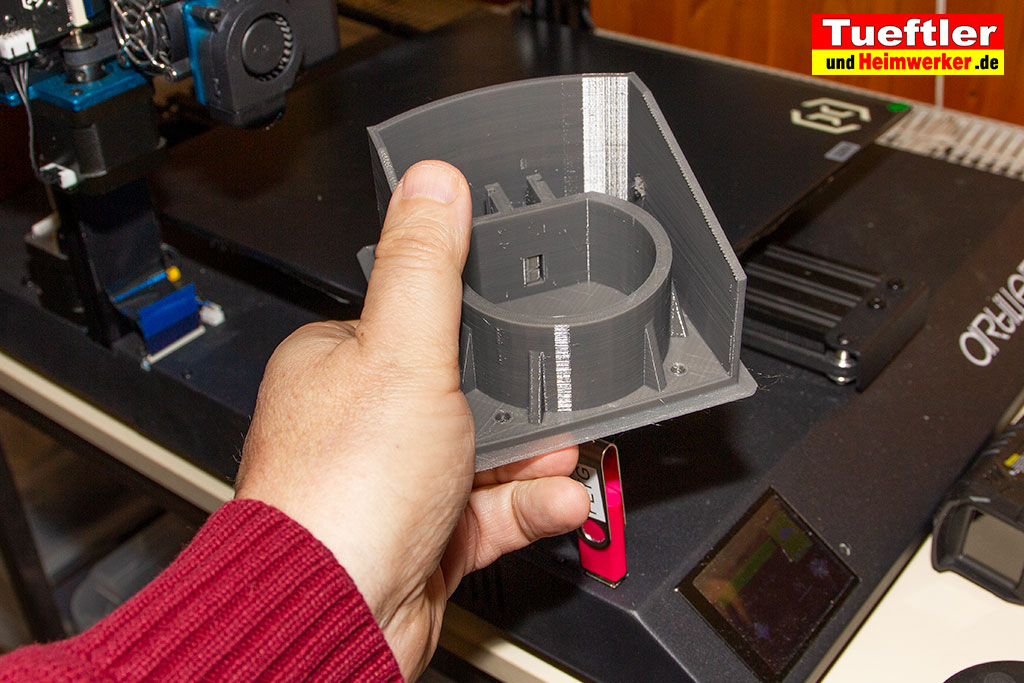
FLEX are printed at a temperature of 200-240 (depending on the material). A heated table is not required. On printers with direct material feed (feed mechanism on the print head), there are usually no problems with printing. On a bowden feeder (the feed mechanism is located on the body), printing with very soft plastics can be difficult. Usually it is necessary to additionally adjust the clamping of the bar. The main nuance is the very low print speeds - 20-40mm.
Pros:
Cons:
Depending on the type of FLEXa, the models can be flexible or rubber-like. This material, depending on its softness, can be used to print gaskets, insoles, belts, tracks or other models that require flexibility or softness.
FLEX belt
Trainers with flexible soles
Wheel for switchgear model
Decorative plastics
Decorative plastics are PLA plastics with various fillers (wood or metal shavings). Or with dyes selected to imitate different materials. Since the base of the plastic is PLA, it is very easy to print.
Or with dyes selected to imitate different materials. Since the base of the plastic is PLA, it is very easy to print.
Extruder temperature - 200-220 degrees (depending on the manufacturer). A heated table is not required.
Pros:
Cons:
-
Some fillers (eg clay) are abrasive. For such plastics, the standard brass nozzle cannot be used. Will have to buy a harder steel nozzle.
-
Some decorative plastics can clog the small nozzle (0.4 or less). For them, you need to use a “thicker” nozzle.
Depending on the filler, different material properties are obtained. Plastics that use only dye do not require additional processing. Materials with "fillers" may sometimes require additional post-processing.
Plastics with metal fillers after printing must be processed with a metal brush. Then the Metal content will show through and the model will resemble a metal casting.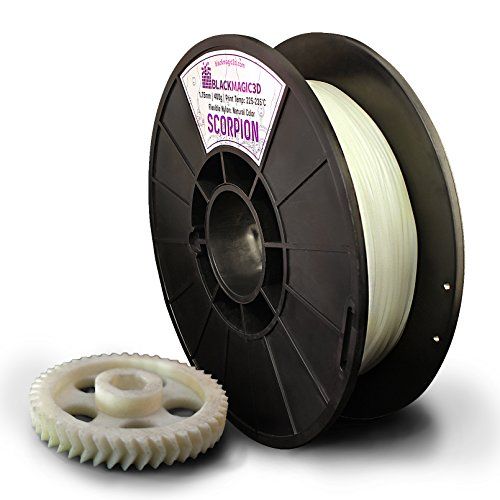
Plastics with metallic powder
These plastics are often used for printing key chains, decorative models and interior details.
If the plastic has a high content of wood dust, then it is recommended to use a larger nozzle diameter (0.5 or more), a smaller nozzle can quickly become clogged during printing.
Wood-filled plastic ground
Plastic key rings with copper dust
Engineering plastics
These are nylon-based plastics with fillers that improve strength, heat-resistant and other characteristics, help to achieve less shrinkage of the material. For example - carbon fiber, carbon fiber or fiberglass.
Extruder temperature - 240-300 degrees (depending on the manufacturer). Table temperature - 90-110 degrees. Since plastics are based on nylon, the requirements for printing are similar. This is a heated table and a closed printer case.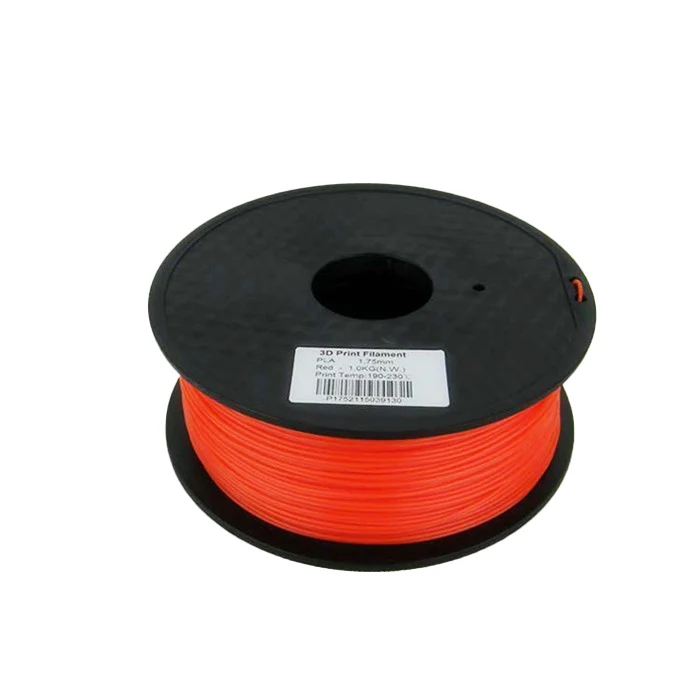
Pros:
-
Hardness and strength.
-
Low flammability or non-combustibility.
-
High precision due to low shrinkage.
Cons:
3D printers use brass nozzles, some plastics can quickly “waste” it during printing. For such materials it is recommended to use steel nozzles.
These are highly specialized plastics used for a specific task, depending on the filler. For example, functional parts that do not lose their shape when heated, are resistant to many solvents, etc.
Functional Carbon Fiber Composite Prototype
Composite frame
Polycarbonate ashtray
Totals
This is of course not the whole list of materials for 3D printing. There are many highly specialized engineering and decorative plastics for specific tasks.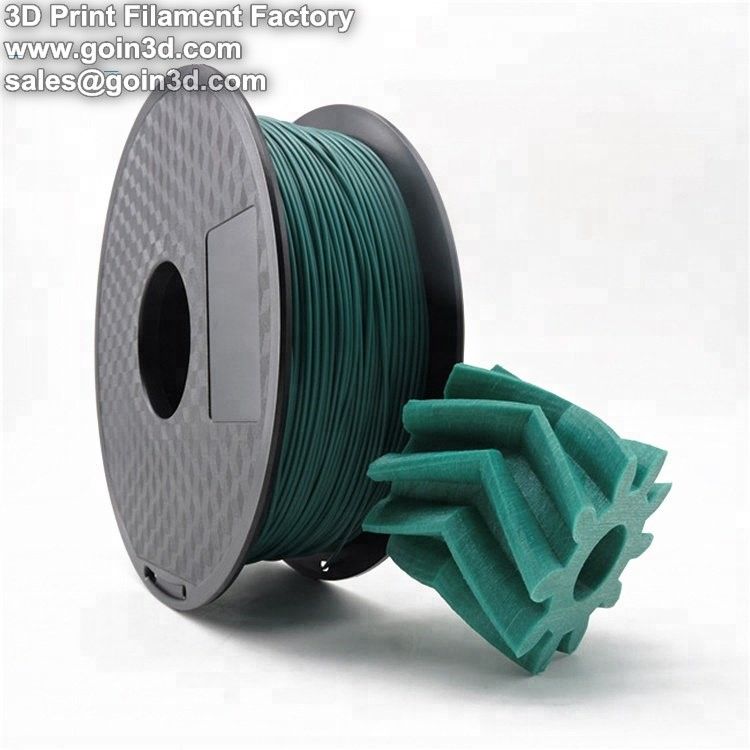
Manufacturers are constantly trying to replenish the range of materials for 3D printing. Already familiar materials are improved for more comfortable printing. There are many interesting decorative plastics imitating different materials - ceramics, clay, wood, metals.
And of course, the assortment of engineering plastics is constantly updated. Now there are many interesting materials for highly specialized tasks - for example, burnable plastic with a low ash content for subsequent casting in metal.
Burnout plastic
Before buying a coil, read the information on the website of the manufacturer or seller. There you can find some nuances of printing for a particular plastic. The manufacturer indicates the recommended temperature range on the box. Sometimes, for quality printing, it is recommended to print several tests to adjust the temperature settings, retract, etc.
Try to store the started coil in silica gel bags.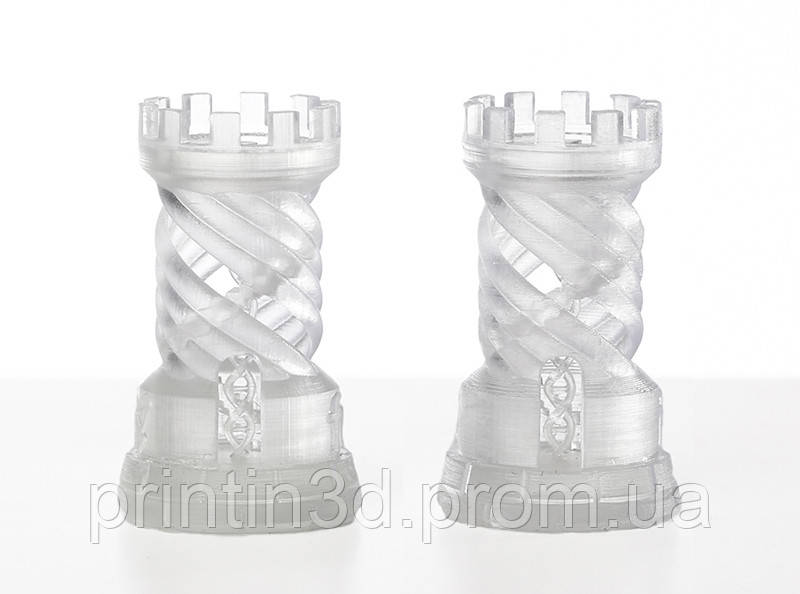 It is recommended to additionally dry high-temperature plastics before printing to remove excess moisture.
It is recommended to additionally dry high-temperature plastics before printing to remove excess moisture.
Add to compare
Product added to compare Go
| Manufacturer | Tiger3D |
Add to compare
Product added to compare Go
| Manufacturer | Esun |
Add to compare
Product added to compare Go
| Manufacturer | Esun |
Add to compare
Product added to compare Go
| Manufacturer | FlashForge |
Best 3D Printing Filaments (For Professional Equipment)
3D printing is increasingly being used in commercial and manufacturing applications. Industrial printing requires special filaments. They are characterized by increased structural support. We offer a list of 9the most popular professional consumables:
No. 1. Professional 3D Printing Filament: Carbon Fiber
Carbon fiber is often added to PLA, ABS, PETG to improve stiffness. Such connections are excellent for use in aggressive environments. The only negative is that the use of these consumables contributes to the rapid wear of the extruder (especially if it is made of soft metal).
Such connections are excellent for use in aggressive environments. The only negative is that the use of these consumables contributes to the rapid wear of the extruder (especially if it is made of soft metal).
#2. Professional 3D printing filaments: PC-ABS
ABS Polycarbonate Alloy is a rigid thermoplastic that combines the strength and heat resistance of polycarbonate with the flexibility of ABS. The material is characterized by hygroscopicity, therefore it causes certain difficulties when working with it. Another disadvantage is that the thread must be printed at a high temperature (at least 260°C). Since PC-ABS tends to warp, a high temperature of the printed layer (at least 100°C) is needed.
#3. Professional 3D Printing Filament: HIPS
High performance polystyrene is a copolymer that combines the hardness of polystyrene with the elasticity of rubber. Combined with ABS in a dual extrusion printer, HIPS is an excellent support material.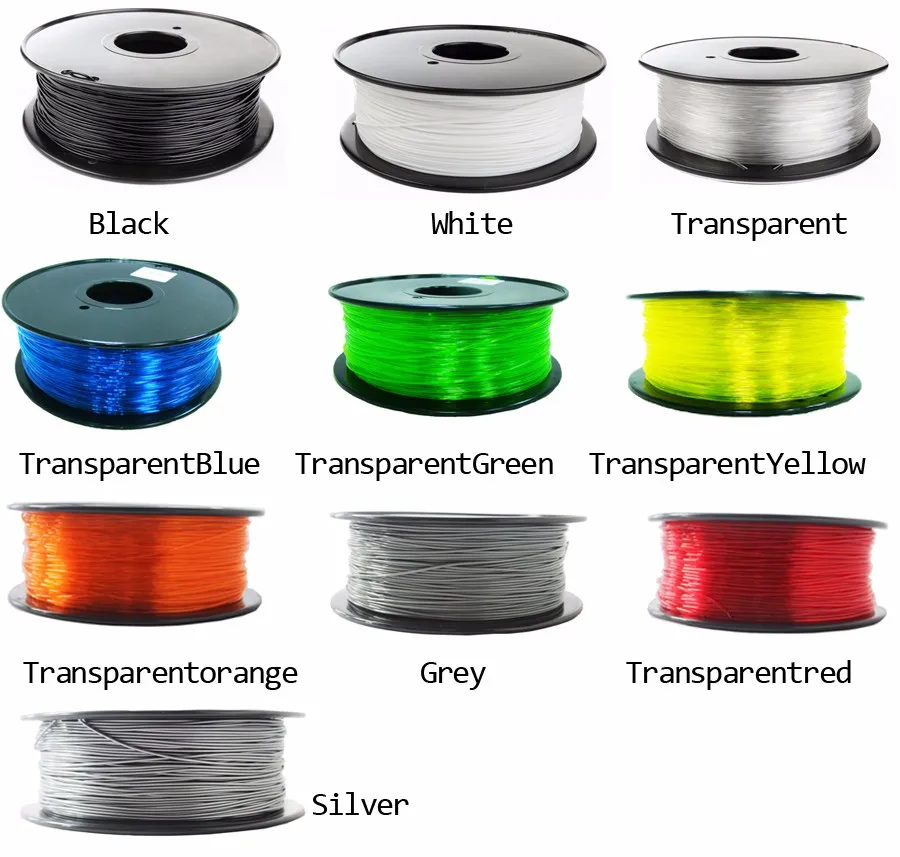 Easy to sand, glue or paint. Doesn't mix well with other threads (except ABS) as they can be damaged by limonene.
Easy to sand, glue or paint. Doesn't mix well with other threads (except ABS) as they can be damaged by limonene.
#4. Professional 3D printing filaments: PVA
Polyvinyl alcohol is water soluble, so it does an excellent job as a support material. Unlike the previous consumable, it is compatible not only with ABS, but also with PLA and nylon.
#5. Professional 3D Printing Filament: ASA
An alternative to ABS designed for greater weather resistance. Acrylonitrile styrene acrylate is not affected by chemicals, high temperatures. This is a durable and tough consumable that is easy to use in additive printing.
#6. Professional 3D Printing Filament: PP
Polypropylene is a strong, flexible, lightweight, chemical resistant and food safe material. True, the thread has a number of disadvantages, including poor adhesion and difficulty in deformation.
#7. Professional 3D printing filaments: Acetal (POM)
Polyoxymethylene (POM) also known as acetal.